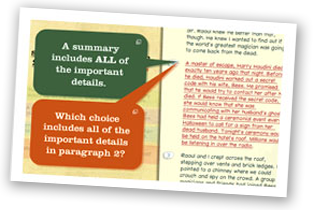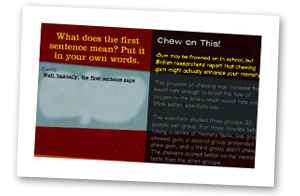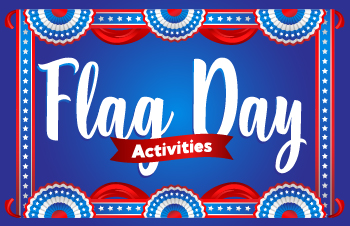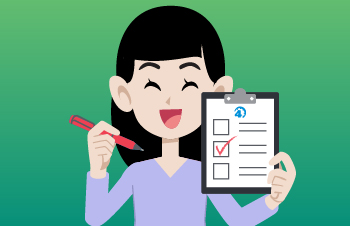Sixth Grade Reading Strategy and Curriculum Standards
An essential part of the 6th grade reading strategy is development of writing skill along with reading skill. Students use language arts worksheets created to help them write clear, coherent, and focused essays. These essays must contain formal introductions, supporting evidence, and conclusions. 6th grade reading strategy language arts lessons encourage children to choose a form of writing such as personal letter, letter to the editor, review, poem, report, or narrative, that best suits their intended purpose, then create multiple-paragraph expository compositions. As part of the 6th grade reading strategy students are expected to engage the interest of their readers and state a clear purpose. They learn to develop a topic with supporting details and precise verbs, nouns, and adjectives to paint a visual image in the mind of their readers and conclude with a detailed summary linked to the purpose of the composition.
Interested in 6th grade reading? Parents might also find the 6th grade curriculum overview helpful.
Writing Applications
Narratives are an important 6th grade reading strategy language arts activity in which they will establish and develop plots and settings, and present text from a point of view appropriate to their stories. While writing they will be instructed to include sensory details and concrete language to develop plot and character, and to use a range of narrative devices including dialogue and suspense. Expository compositions include description, explanation, comparison and contrast, problem and solution. They should state a thesis or purpose, explain the situation, follow an organizational pattern appropriate to the type of composition, and offer persuasive evidence to validate arguments and conclusions as needed.
Other 6th grade language arts lessons develop research report writing and reading skill. 6th grade reading strategy students are expected to pose relevant questions with a scope narrow enough to be thoroughly covered in their reports. They then support the main idea or ideas with facts, details, examples, and explanations from multiple authoritative sources such as speakers, periodicals, and online information searches, and include a bibliography.
Literary response is another important aspect of the 6th grade reading strategy. Students will develop an interpretation exhibiting careful reading skill, understanding, and insight. Language arts lessons in literary response will show students how to organize their interpretations around several clear ideas, premises, or images. They will be asked to develop and justify interpretations through sustained use of examples and textual evidence. The writing of persuasive compositions is yet another important aspect of the 6th grade reading strategy. Students learn to state a clear position on a proposition or proposal, support their position with organized and relevant evidence, and anticipate and address reader concerns and counterarguments. Language arts worksheets may be used to help students organize their thoughts prior to writing.
Good grammar is of vital importance for 6th grade reading strategy students. This year they use language arts worksheets to learn to identify and properly use indefinite pronouns and present perfect, past perfect, and future perfect verb tenses. They learn to ensure that verbs agree with compound subjects. They are expected to use simple, compound, and compound-complex sentences, and to use effective coordination and subordination of ideas to express complete thoughts.
Punctuation lessons, another vital language arts activity, includes the use of colons after the salutation in business letters, semicolons to connect independent clauses, and commas when linking two clauses with a conjunction in compound sentences. 6th grade students are expected to use correct capitalization when completing their language arts lessons. The 6th grade reading strategy also emphasizes the need for children to practice spelling frequently misspelled words correctly.

At first, I was skeptical about using a computer program for reading. But the progress we made is really clear and I couldn't be happier that we tried it!
In sixth grade language arts, there is an emphasis on reading comprehension and writing skills.

Speaking – Reading Strategy
The 6th grade reading strategy includes development of listening and speaking skills. Students deliver focused, coherent presentations that convey ideas clearly and relate to the background and interests of the audience. They evaluate the content of oral communication of others. This vital language arts activity adds to a student’s reading skill and comprehension as they learn to listen critically and respond appropriately to oral communication. 6th grade language arts lessons help them select a focus, an organizational structure, and a point of view, matching the purpose, message, occasion, and vocal modulation of the audience.
6th grade reading strategy language arts worksheets may be used to help children organize their speeches. They are expected to emphasize salient points to assist their listeners to follow main ideas and concepts, support opinions with detailed evidence and with visual or media displays that use appropriate technology, and use effective rate, volume, pitch, and tone and align nonverbal elements to sustain audience interest and attention.
6th grade reading strategy students deliver well-organized, formal presentations employing traditional rhetorical strategies including narration, exposition, persuasion, and description. Student speaking should demonstrate an ability to use standard American English. Elements of the speaking component of their language arts lessons will be to deliver narrative presentations, informative presentations, oral literary response, persuasive presentations, and presentations on problems and solutions.
6th grade students deliver well-organized narrative presentations demonstrating 6th grade reading skill in establishing a context, plot, and point of view. Their narrative presentations should include sensory details and concrete language to develop a plot and character, and use a range of narrative devices such as dialogue, tension, and suspense. These language arts lessons also require that 6th grade reading strategy students deliver informative presentations that pose relevant questions sufficiently limited in scope to be completely and thoroughly answered. They should develop their topics with facts, details, examples, and explanations from multiple authoritative sources such as speakers, periodicals, and online information.
Oral responses to literature are another component for the 6th grade reading strategy. Students are instructed to develop interpretations exhibiting careful reading skill, understanding, and insight. They organize selected interpretations around several clear ideas, premises, or images, then develop and justify the selected interpretations through sustained use of examples and textual evidence. Language arts worksheets are helpful in preparation for the delivery of persuasive presentations.
Students learn to provide a clear statement of their positions, include relevant evidence, offer logical sequences of information, and engage listeners enough for them to consider acceptance of the proposition or proposal. Finally, 6th grade reading strategy students deliver presentations focusing on problems and solutions. To do this they learn to theorize on causes and effects of each problem, establishing connections between the defined problems and at least one solution per problem. During the course of their oral presentations they offer persuasive evidence validating the definition of the problem and the proposed solutions.
Another vital part of the 6th grade reading strategy is for students to demonstrate their comprehension listening and reading skill. They learn to relate a speaker’s verbal communication to the nonverbal messages, identify the tone, mood, and emotion conveyed in an oral communication, plus restate and execute multiple-step oral instructions and directions. Language arts activities for the 6th grade reading strategy includes analysis of the use of rhetorical devices including cadence, repetitive patterns, and onomatopoeia, for intent and effect. They also identify persuasive and propaganda techniques used in television and identify false and misleading information.
More: 6th Grade Spelling Words.
Is your child being homeschooled?
*Reading Standards are defined by each state. Time4Learning bases its use of 6th Grade reading standards on the national bodies that recommend curriculum and standards and the interpretations of it by a sampling of states notably Florida, Texas, and California.

In sixth grade language arts, students practice reading comprehension strategies and learn how to summarize parts of a story.
In Chapter 2 - Think Alouds, students read a story excerpt and summarize, predict outcomes and answer questions about the text.

Development Of Reading Skills
Language arts lessons for 6th grade reading strategy students include development of reading skill by use of a variety of effective and coherent organizational patterns, including comparison and contrast, organization by categories, and arrangement by spatial order, order of importance, or climactic order. 6th grade reading strategy language arts activity requires that they revise writing to improve the organization and consistency of ideas within and between paragraphs. 6th grade students need to write narratives and expository, persuasive, and descriptive texts of at least 500 to 700 words in each genre. Their writing should show a command of standard American English and 6th grade reading strategy research, reading skill, organizational, and drafting strategies.
Genres explored in the 6th grade reading strategy and language arts worksheets include narratives, expository compositions, research reports, literary response, and persuasive compositions. 6th grade students utilize organizational features of electronic text, exploring bulletin boards, databases, keyword searches, and using e-mail addresses, to locate information. When composing and formatting documents using a computer they demonstrate word-processing skills and principles of design including margins, tabs, spacing, columns, and page orientation.
The Time4Learning Program Structure
Time4Learning has been refined through years of feedback from educators, parents, and students. Subjects are organized into chapters composed of interactive lessons, printable worksheets, quizzes and tests. Students are guided through the activities at their own pace by an automated system.
When students log in, they choose a subject, select a chapter, pick a lesson and complete the activities. A bright green arrow tells them where they left off, and completed work is clearly labeled with a check-mark or a gold star. Visual and auditory prompts guide students through the lessons, making it easy for even young learners to follow, and an online playground (controlled by parents) rewards and motivates them to finish their lessons.
Parents get access to printable lesson plans, teaching tools, detailed reporting and parental support through our online Parent Forum.
Does your child have different achievement levels for math and language arts? No problem!Time4Learning lets you set each individual subject at the appropriate graded level, making this program great for special needs and gifted students.









